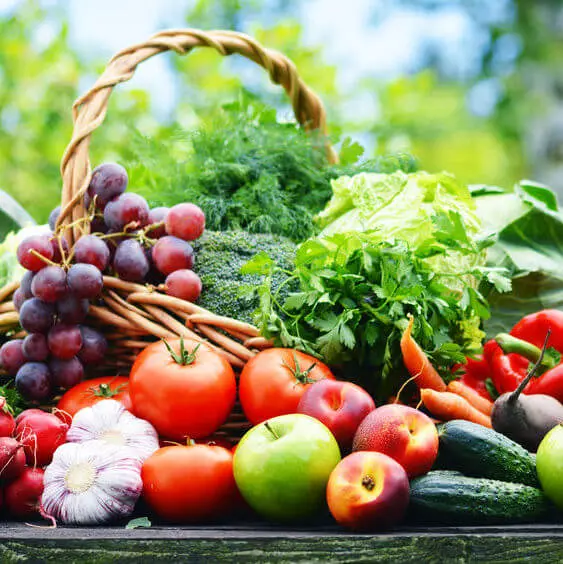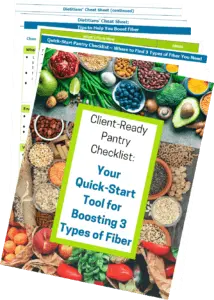
7 Ways Variety Can Help Make Healthy Eating Easier
Can you take the problems posed by too much variety in our food — discussed in a previous research review — and turn them around to make healthy eating and a healthy weight easier?
Yes! Whether for improving what kids or adults eat, research shows that smart use of the right kind of variety can lead to healthier eating. Let’s explore some options you might try out to see how healthy eating may be more doable than you realize.
1) Let Variety Take the Ho-Hum out of Healthy
As we discussed in my research review about the “dark side” of variety, more variety in our food choices keeps us from getting bored with our food and stimulates us to eat more. Moreover, when additional options are available at one time, even if we don’t try them all, in most situations, it stimulates the urge to try at least a few.
In presentations about creating eating habits to lower cancer risk and promote health, when I talk about including more vegetables and fruits and ask people about the barriers they see to doing so, one that always comes up is that it sounds BORING. What a shame! With the huge number of different vegetables and fruits in our grocery stores, and unlimited ways of preparing, combining and flavoring them, vegetables and fruits provide an instant way to make any meal something new and different by simply switching around your choices.
The problem is the blinders we wear. When I run through a list of some readily available, but less-commonly-chosen vegetable and fruit options and ask those people with their hands up indicating they find vegetables and fruits boring about how many they’ve tried, the numbers tell the story. When we then look at how much variety in whole grain choices – beyond whole wheat bread, brown rice and whole grain pasta – people have explored, it’s clear why whole grains are also deemed “boring”, despite the many interesting grains now available in most stores.
We’re looking for variety in the wrong places. People jump to try ice cream flavor #53 or its combination with any candy imaginable. We treat variety based on how many high-calorie, low-nutrient foods can be put on a burger or wrapped inside some kind of dough as exciting. Yet we largely ignore the wide variety of health-promoting vegetables, fruits, whole grains and beans, as well as the nuts, seeds, herbs and other flavorings that make them different every time.
Let’s change that, and turn boosting vegetables, fruits, whole grains and beans into a fun and exciting way to eat.
2) Plan meals… at least a little
Part of how we sink deeper and deeper into a rut comes from not planning meals, and trying to decide what we’ll eat just 30 minutes (or less) before a meal. At that point, even if you’ve taken the bold step of bringing some new vegetable or whole grain choices home from the store, you probably are not in the frame of mind to figure out how to prepare them. When rushed and stressed, it’s far more comfortable to stick with what we know.
People differ in the form of planning that works best for them.
- For some, it’s helpful to have the structure of knowing specific meals to serve each night, and perhaps each lunch, too, for those who eat at home or pack and carry. Once meals are planned and you’ve shopped to have necessary items on hand, the “what on earth are we doing to have?” last-minute dilemma is gone. You can designate one time a week to plan meals, looking ahead to special circumstances like late days at work or evening events that will necessitate especially quick-fix meals.
- The structure that is sanity-saving for some people seems suffocating to other people. That doesn’t support throwing meal-planning out the window, however. A more flexible approach to meal planning can mean coming up with ideas for several meals without assigning them to particular days or even particular dishes.
- If you thrive on even more spontaneity, you can simply do your grocery shopping by knowing that you are picking up enough vegetables and fruits to match the number of days for which you are shopping, and keep a stash of many different whole grains and beans at hand in your pantry. Then when mealtime is near, do a quick search on a few favorite websites for new ideas of how to use what you purchased.
3) Do Reconnaissance on How to Prepare New Foods.
Whatever degree of planning structure works best for you, make it a game to try at least one or two new vegetables, fruits, beans or whole grains each week. For those who are less spontaneous, even if you don’t plan your other meals, this can be more comfortable by exploring different options for using these new choices ahead of time, so that you are familiar with how much time they will take and how you’ll prepare them. Make expanding variety fun, not stressful!
In the Resource list below, you’ll find excellent sources of inspiration for new vegetables, fruits, whole grains and beans you can try, as well as ideas for serving them.
4) Consider Gentle Variety for Those Who are Reluctant.
If you seek variety only because of the potential it offers for health benefits, or are eating with others who do not embrace variety in eating, you can let an expanded variety of nutritious foods “fly under the radar”.
- Add new vegetables, but flavor them like more familiar options, or serve them in combination with other well-loved foods. Include one new vegetable in a stir-fry or soup consisting of mostly familiar vegetables, or add a new vegetable in a casserole or mixed dish where it will be less visible. Choose a new whole grain option to replace a refined grain in a favorite casserole or soup, or to serve as the foundation topped by a well-loved stir-fry or other mixed dish.
- When adding one of the vegetables that can have a stronger flavor, such as broccoli and some other cruciferous vegetables, serve raw or be sure not to overcook (flavor can get stronger), and serve along with a flavoring that can subdue the taste while palates get used to it. For example, adding a stronger-flavored vegetable to a dish with a cheesy sauce like lasagna, or a flavorful dish such as chili, or an Asian-flavored stir-fry with a bit of hoisin sauce or a sweetly spicy peanut sauce, can tone down the vegetable’s flavor.
5) Let Dramatic Variety Enhance the Positive
If your low consumption of vegetables, fruits, whole grains and beans is because they seem boring, be intentional about stepping out of the rut of limited choices. Have fun with new ways of serving them as the focal point of your meal.
- Go international by choosing a country you yearn to visit or have seen in a recent book or movie, and find out some of the most common vegetables in that cuisine. If you have children or grandchildren, choose a country they’ve studied or read in a book, and get them involved. (You can do this even from a distance via email or Skype.)
- Try the typical flavor combinations of countries that interest you as a flavoring for vegetables most used there or for other vegetables you want to try. It’s called Fusion Cuisine when two or more different culinary traditions are combined, and you can create your own type of fusion!
- Explore different types of whole grains beyond your usual. Look up completely new recipes created for that grain, or try out a new whole grain by using it in a dish with which you’re already familiar. For some people, whole wheat couscous, bulgur, barley and quinoa are new choices; others can look to wheat berries, amaranth, freekeh, and whole farro. Some whole grain varieties come naturally in different colors like red or black that add a sense of adventure and color appeal.
6) Use variety to encourage a healthy weight.
You can use its influence to subtly encourage lowest calorie dishes as the ones with which to fill up.

One way to add variety to raw vegetables: White Bean & Rosemary Dip made with plain Greek yogurt
- Remember that to reduce calorie consumption, the goal is swapping low calorie foods as a replacement for those higher in calories, not eating more. Take a mixed dish that is typically focused around meat or something starchy (like pasta, rice or potatoes), and within the same portion, give those a smaller role and non-starchy vegetables a larger role. This works in casseroles, stir-fries and stews of many kinds. You’ll eat fewer calories even while consuming your usual size portion. Chopping up a few extra vegetables to mix in takes less time than you may think; frozen vegetables, already cleaned and chopped, offer a super-fast way to do this.
- In addition to boosting vegetables in a mixed dish, serve a different vegetable as a side dish. For everyday meals, I am rarely looking for ways to make more dishes, but the side dish can be some simple raw vegetables to eat plain or with a little dip, or an easy salad. People eat less when serving bowls remain on the stove or kitchen counter instead of being brought to the table. If you want to encourage vegetable consumption, however, you might put a serving bowl of vegetables or salad on the table, and see how much easier it is to go back for a little more.
7) Use variety to encourage healthy eating by children.
If you are feeding children, research suggests that even more than adults, children prefer a variety of food choices on their plates in a wide variety of colors. Note that this doesn’t mean excessive amounts of food, but greater variety within the same total amount.
- Try providing self-serve variety. Even kids who might not eat the vegetables you put on their plate often surprise parents with the vegetables they take (and eat!) when the meal is a make-your-own dish. You put individual bowls with a variety of vegetables on the table, and each person chooses their own medley to add to burritos or a main dish salad. Go ahead – include one unique vegetable or fruit in the options, or perhaps a relatively new choice that you’ve previously introduced as part of a familiar mixed dish.
Variety in the Diet: Yes! The Right Kind Does Pay Off
It’s true that too much variety – too many choices enticing you to overeat and choose foods that work against your health – is a negative. However, aiming for a variety of nutrient-rich fruits and vegetables may provide an extra boost to reduce risk of heart disease and other chronic diseases beyond that from simply eating greater amounts. What’s more, a variety of nutrient-rich foods can keep a healthful eating pattern fun and exciting, promoting the long-term habits that make a difference for health.
⇒ Free Client-Ready Checklist:
Variety in the Diet: How to Turn Barriers to Benefits
Now you see that adding the right kind of variety can make healthy eating either easier and more fun, with less reliance on willpower. Get this checklist to help create personalized strategies – and get ideas to help avoid the pitfalls of too much variety, too.
Just click here.
You’ll get this practical checklist of tips… and receive future nutrition research reviews straight to your email inbox so you won’t miss a thing.
Need ideas of specific choices in fruits, vegetables, whole grains and beans that can add healthful variety to your eating? Browse these resources for ideas of foods to try and how to prepare them.
Explore the list of Vegetables and Fruits from Have a Plant, a program of the Produce for Better Health Foundation. Pick a few to try, and you’ll have tips for selecting and preparing them.
Check this resources page on the Oldways Preservation Trust website, where you can find tip sheets on “12 Great Ways to Use ….” foods from artichokes, beets and cabbage to kale and peanuts.
When it comes to exploring whole grains, you can’t do better than the Whole Grains Council. Click here to view their Whole Grains 101 describing different grains for you to try, then explore the rest of the site for more info.
The International Vegan Union offers recipes from around the world that you can prepare or use for ideas of flavor principles in different cuisines that you can use for flavoring other new vegetables, whole grains and beans. You don’t need to be vegan to enjoy the interesting dishes featured.
Want to use soy in more ways? The United Soybean Board’s Soy Connection provides recipes and information on different soy foods.
Lentils are a quick-fix option for legumes that can be used in many enjoyable dishes. Check the great Recipes from USA Dry Pea and Lentil Council, and Lentils for Every Season recipe collection from Saskatchewan Pulse Growers.
Check your library for cookbooks that focus on a variety of vegetables, fruits, whole grains and beans as the key to a healthful, delicious and utterly doable way of eating. Every time I flip through my copy of The Plant-Powered Diet by Sharon Palmer, RD, I get fresh inspirations. I also love Mollie Katzen’s book, The Heart of the Plate, which is like a love letter to vegetables. Like several of her other books, it provides fresh ideas to keep the healthful variety going in my family’s meals. If your library doesn’t have copies of these or other inspiring plant-focused cookbooks that you can borrow, buy one and consider it an investment in your health.
Purchased from 123rf.com/profile_ monticello
3 Comments
Leave a Comment
Published : March 4, 2014 | Last Updated: June 5, 2022
Tagged: cancer prevention, fruits, healthy diet, healthy eating, heart health, plant-based diet, variety, vegetables, weight control, whole grains
Meet the author/educator
I Take Nutrition Science From Daunting to Doable.™
As a registered dietitian nutritionist, one of the most frequent complaints I hear from people — including health professionals — is that they are overwhelmed by the volume of sometimes-conflicting nutrition information.
I believe that when you turn nutrition from daunting to doable, you can transform people's lives.
Accurately translating nutrition science takes training, time and practice. Dietitians have the essential training and knowledge, but there’s only so much time in a day. I delight in helping them conquer “nutrition overwhelm” so they can feel capable and confident as they help others thrive.
I'm a speaker, writer, and nutrition consultant ... and I welcome you to share or comment on posts as part of this community!




Check out what Houston has done to encourage increasing Veg intake during National Nutrition Month. This is promoted by Recipe for Success:
http://www.vegoutwithrfs.org/
Thanks for sharing this, Sharon!
I encourage everyone to check this out! I love the “30 Ways in 30 Days Challenge”! Any of you who join in and aim to eat 30 different vegetables this month, please come back and comment here. I’d love to hear how it goes. Hint: Whether you enter the challenge or set your own goals, the website Sharon provided has recipes for a huge assortment of vegetables A-Z by clicking in the left side columns. Worth a look and a try!
[…] to prompt you to reach recommended amounts. Check out Part 2 in my earlier Smart Bytes series for practical tips on how to make variety work for […]